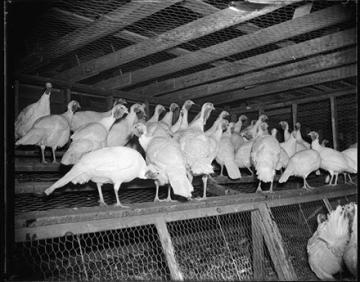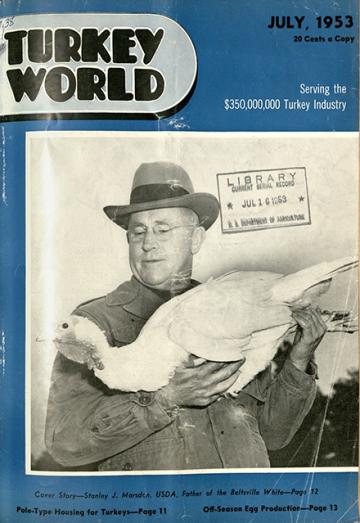Changing Tastes: Rise and Fall of the Beltsville Small White Turkey

Harris & Ewing, photographer. (circa 1937). Turkeys at Beltsville. Library of Congress Prints and Photographs Division Washington, D.C. Harris & Ewing photograph collection. Available at: https://www.loc.gov/pictures/item/2016872986/
Turkeys get top billing this time of year. From the silver screen to the White House to your dinner table, everyone wants to talk turkey. And while these famous birds have been integral to our Thanksgiving holiday for generations, our desires for different types of turkeys have been ever changing.
Take the Beltsville Small White Turkey, for example. According to historian Andrew F. Smith, “the bronze turkey breed was the most popular in the United States during the 19th and early 20th centuries. Its large size, hardiness, and the coloring of its feathers made it popular at the market, where it demanded the highest prices.”
But in the 1930s, consumers expressed a growing desire for smaller turkeys (8-15 pounds) that would better fit their home refrigerators and ovens, and would adequately feed a small family without excess waste. In addition, they wanted a turkey that had more white meat. At the same time, ARS poultry scientists working in the then-named USDA Beltsville Research Center were collaborating with the turkey industry to breed a new turkey to meet the emerging consumer demand.

McPhee, D.G. (1939). A Business Approach to Farm Surpluses. Washington, D.C.: National Association of Food Chains. Available at: https://hdl.handle.net/2027/uiug.30112069610621
Taking advantage of market research, the USDA research team led by Stanley J. Marsden developed the Beltsville Small White Turkey. The team gave the bird its name because of its place of origin (Beltsville, MD) size (small), and color (white). The Beltsville Small White was a cross of several breeds, including standardbred Bronze, small-type Canadian Bronze, Broad Breasted Bronze, Black, wild turkey, White Holland, Narragansett, and White Austrian varieties. The result was a new turkey breed with high hatchability, early maturity, more breast meat, and size more adequate for small families as well as their ovens.
The Beltsville Small White was an instant hit. Marsden reported that “from a small beginning in 1947, when the production of Beltsville Small White turkeys was estimated…to be about 700,000 birds, production increased rapidly to a peak of about 19 million in 1954; after which it declined to an annual average of about 11 million birds for the years 1960 to 1965 inclusive.” From 1960 through 1965, approximately 11 percent of domesticated turkeys in the United States were wholly or predominantly of Beltsville Small White breeding.
After achieving two decades of success, the 1970s started to come into view, and with it a shift in consumer demand for larger turkeys. Specifically, commercial food processors were looking for larger-breasted turkeys and producers wanted larger-sized flocks. Consequently, the Beltsville Small White turkey began a steady decline in popularity.

Stanley J. Marsden pictured on cover of July 1953 issue of the trade journal, Turkey World. He is described as the "Father of the Beltsville White."
Today, the Beltsville Small White is considered a heritage breed, meaning a select variety of farm-grown turkey that retains historic characteristics that are no longer present in most domesticated turkeys. Aside from a few hobby and experimental flocks, the Beltsville Small White is close to extinction.
The Livestock Conservancy observes, "today the Beltsville Small White is quite rare and kept by few exhibition breeders. A research flock exists at the Iowa State University; however, public access to this flock is almost non-existent. In recent years there has been a revival of interest in this variety. Efforts are underway to locate and conserve any remnant flocks in the United States and Canada."
The renewed appreciation of these heritage breeds is apparent among small producers and the larger culinary world. In 2014, the staff of the magazine Cook's Illustrated held a taste test for heritage turkeys and noted that, for the Beltsville Small White, the "tasters raved about the buttery, nutty-sweet, incredibly satisfying, rich flavor of the meat." Perhaps the Beltsville Small White could be saved after all. As noted by Julie Gauthier, a veterinarian with USDA and owner of a small farm where she is working to save the Beltsville Small White, "To save them we have to eat them." — By Scott Hanscom, National Agricultural Library.
For more reading: The Beltsville Small White: A Heritage Turkey
You May Also Like

